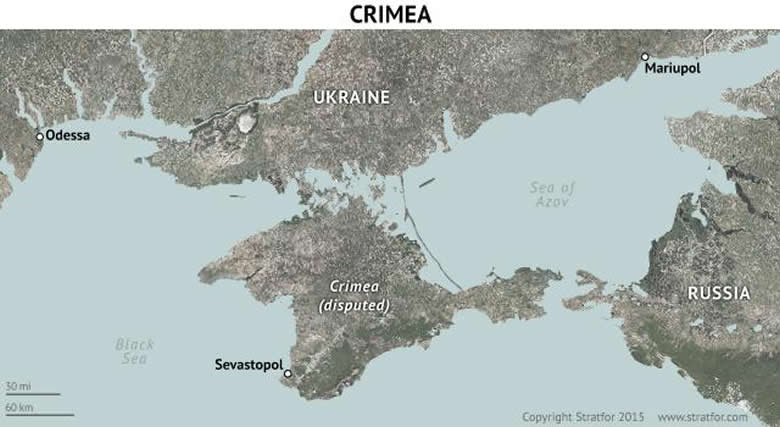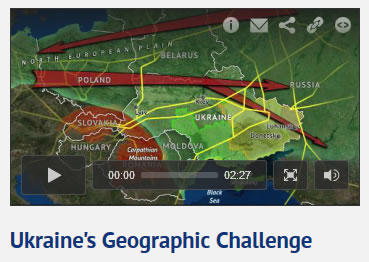A Closer Look At Ukraine Mariupol Crisis
Politics / Ukraine Civil War Jan 26, 2015 - 10:04 AM GMTBy: STRATFOR
 As the situation on the ground quiets down in the wake of the Jan. 24 barrage by Russian-allied forces near the Ukrainian city of Mariupol, Stratfor is continuing the watch initiated by our Red Alert. We believe, at the very least, that Russia is keeping its option to mount an offensive open, and at most, is preparing to launch an offensive to secure its hold on the Crimean Peninsula.
As the situation on the ground quiets down in the wake of the Jan. 24 barrage by Russian-allied forces near the Ukrainian city of Mariupol, Stratfor is continuing the watch initiated by our Red Alert. We believe, at the very least, that Russia is keeping its option to mount an offensive open, and at most, is preparing to launch an offensive to secure its hold on the Crimean Peninsula.
The artillery barrage in Mariupol has died down, and according to the Ukrainian military's local commander, there have been no attacks today. Some diplomacy is spinning up, and mutual charges of responsibility are being exchanged. The pro-Russian faction is blaming the Ukrainian military for the attack, and the Ukrainians are charging that the Russian military initiated the barrage, not Ukrainian pro-Russian factions. The fog of war is being supplemented by deliberate disinformation on all sides. The issue is whether this was an isolated incident or part of an extended strategy. If it is, it is not a Ukrainian strategy. Following recent defeats, Ukraine is not in a position to go on the offensive in this region, despite a noticeable build up and mobilization of Ukrainian forces in recent weeks. The Russians, however, have been moving regular forces, including some first-rate units, into Donbas. More important than the charges and counter-charges is this fact: At this moment, the rebels are being strongly reinforced by Russian forces, and those forces have an operational advantage but a strategic problem.

Consider this from the standpoint of a Russian military planner. The operational advantage is that the separatists have more and better forces available for combat. The strategic problem is that this advantage is temporary. If the United States chooses to increase arms transfers and training, the operational gap will close in 6-12 months. The rebels' broader strategic problem is geographical. Russia holds Crimea, but it has little sustainable contact with its forces there. Both sea and air transport can be interdicted. The best access to the peninsula is by land, but the routes are heavily defended by mobile and strategic surface to air missiles and armor to the north. Opening the route up would not be easy, but it would dramatically increase Ukraine's cost of severing Russia's link to Crimea. Without this, blockading Crimea would be relatively easy for the United States, Ukraine and other allies once their capabilities are increased and more units are deployed.
There is a connection to Crimea over the Kerch Strait from Russia proper of course, now based on ferry traffic but with plans for a bridge. But if war were to come, such tenuous links can easily be closed by a capable enemy. They are useful in peacetime, but vulnerable in war and near-war situations.
Ukraine's Geographic Challenge
 If Russia is serious about holding on to Crimea, it has a diplomatic route and a military route that it can use. The diplomatic route would be to gain international recognition of its hold on Crimea. That will be difficult to get, certainly if Russia is passive. The alternative is to create a military presence that might be attacked but would have significant ability to resist. The third option is to use the threat of an attack on Ukrainian positions to force a more favorable political settlement. If that fails, Russia still has the superior strategic position that it has now.
If Russia is serious about holding on to Crimea, it has a diplomatic route and a military route that it can use. The diplomatic route would be to gain international recognition of its hold on Crimea. That will be difficult to get, certainly if Russia is passive. The alternative is to create a military presence that might be attacked but would have significant ability to resist. The third option is to use the threat of an attack on Ukrainian positions to force a more favorable political settlement. If that fails, Russia still has the superior strategic position that it has now.
If the Russians are serious about holding Crimea, and if their calculation of how the correlation of forces will shift over coming months is the same as ours, then they now have a window of opportunity to redefine the strategic reality using their current operational superiority. Whether this results in a diplomatic settlement instead of further combat will be up to the West.
The counter-argument will be that, given Russia's economic problems, the diplomatic consequences of further offensive operations would increase the strain on Russia. From a political point of view, however, pure passivity in the face of sanctions that are not the critical factor in Russia's economic downturn will hurt the government's legitimacy at home while offering no real economic advantage. In addition, the Americans are not eager for a Ukrainian conflict while their forces are engaged in the Middle East. Therefore, while nothing is certain, a Russian strategist might well calculate that the risks of passivity are higher than those that come with an offensive. The military buildup in Donbas, the concentration of artillery, certain incursions by Russian aircraft that would be needed to keep Western aircraft at a distance from the battle zone, including aircraft with standoff anti-armor capabilities, indicate to us that the Russians are at least keeping this option open, and at most, are preparing to launch an offensive.
Good strategy involves creating options while withholding commitment to any particular course until the political and diplomatic possibilities are played out in the context of a build up. It would seem to us that this is what the Russians are doing, while signaling capability if not yet intent. However, the Americans sending the commander of the U.S. Army to Kiev on a very public visit is a signal that the window is closing. That forces Russia to make decisions sooner rather than later.
The Red Alert we issued yesterday was triggered by what appeared to be artillery preparation by the Russians at exactly the point when a move toward Crimea would be launched. That was alarming. We think it was meant by the Russians to be alarming, a warning of Russian operational superiority and strategic imperatives. Things have quieted down. The quiet ought not to be taken as the end of anything.
We call Red Alerts when action is underway. While the action has now halted, the underlying crisis is intensifying. There are exits from the path to an offensive, though it is not clear that either side is prepared to pay the toll needed for the exit.
"Red Alert Update: At the Heart of the Mariupol Crisis is republished with permission of Stratfor."
This analysis was just a fraction of what our Members enjoy, Click Here to start your Free Membership Trial Today! "This report is republished with permission of STRATFOR"
© Copyright 2015 Stratfor. All rights reserved
Disclaimer: The above is a matter of opinion provided for general information purposes only. Information and analysis above are derived from sources and utilising methods believed to be reliable, but we cannot accept responsibility for any losses you may incur as a result of this analysis.
STRATFOR Archive |
© 2005-2022 http://www.MarketOracle.co.uk - The Market Oracle is a FREE Daily Financial Markets Analysis & Forecasting online publication.



